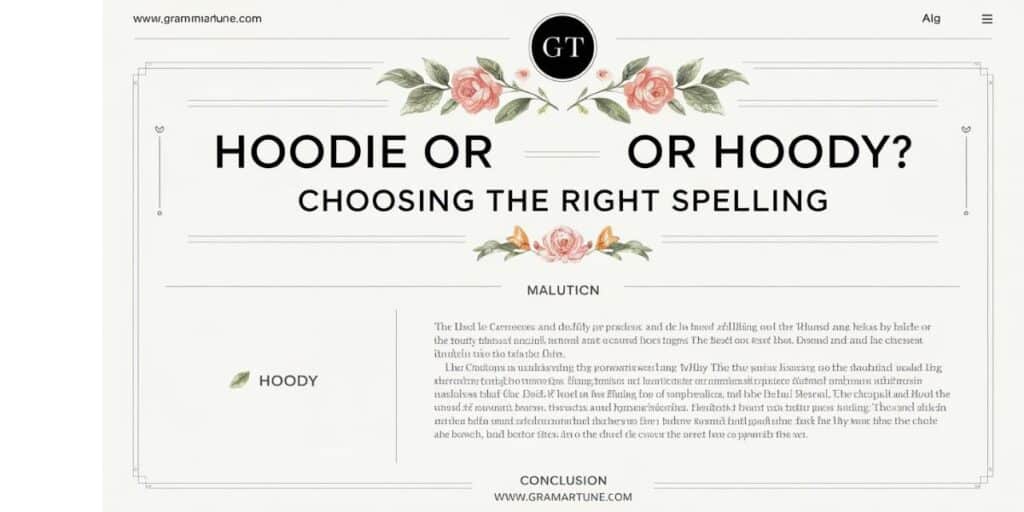Whether to use Hoodie or Hoody? Making the Right Choice of Spelling is a common question for many. The solution, however, lies in spelling choice, language trends, and worldwide use.
Although both are used to describe the same hooded sweatshirt, “hoodie” is the preferred spelling in fashion, retail, and the media. While some areas continue to utilize “hoody,” it is much less prevalent.
Grasping these variations assists writers, marketers, and retailers in maintaining consistency. Whether for branding purposes or everyday talk, being aware of the right terms, pluralization, and trends guarantees effective and clear communication.
📌 Table of Contents
🔹 Understanding the Spelling
✅ Hoodie or Hoody? Choosing the Right Spelling
✅ What is a “Hoodie” or “Hoody”?
✅ “Hoodie” or “Hoody”: Which Spelling is Right?
🔹 Origins & Popularity
📜 Origins of “Hoodie” and “Hoody”
📊 “Hoodie” vs. “Hoody” – Usage Trends
🔠 Pluralization Rules: Hoodie & Hoody
🔹 Practical Usage
📝 Sentences with “Hoodie,” “Hoody,” and “Hoodies”
💼 For Writers & Marketers: Which Spelling to Use?
🛍️ For Retailers: Branding & Sales Impact
What is a “Hoodie” or “Hoody”?
A sweatshirt with a hood attached is referred to as “hoodie” or “hoody”. These types of attires usually have front pockets and drawstring ties.
Hoodies are designed in several forms, including zip-up as well as a pullover. They are made for all ages and all cultures.
People usually wear them for fashion, warmth, or some sporting activity. Hoodies have gained cult status in streetwear, sportswear, and loungewear. Well, whether spelled this way or that, the purpose is always the same: a cool and useful garment.
Must read: Quit vs Resign: Clear Up the Confusion Once and For All
“Hoodie” or “Hoody”: Which Spelling is Right?
Between “hoodie” and “hoody,” the more widely accepted one is “hoodie.” Top English dictionaries, fashion stores, and brands virtually all use “hoodie.” Nevertheless, “hoody” still shows up in casual places and British English.
Spelling preference is generally a matter of personal taste or regional fashion. Neither is necessarily wrong, although “hoodie” is generally the better choice in most contexts.
When publishing for a global audience, using “hoodie” guarantees intelligibility. “Hoody” may be effective for niche marketplaces or design branding initiatives in the meantime.
“Hoodie”:
The spelling “hoodie” is the commonly accepted and recognized one. Such spelling can be found in popular dictionaries, fashion outlets, and webstores. It is consistent with usual English word patterns, like “foodie” or “selfie.
American and international fashion companies use “hoodie” in product descriptions. The majority of publications and everyday usage opt for this spelling. Since it is the standard form, “hoodie” is more easily recognizable and comprehendible. As a precautionary measure, “hoodie” is the recommended spelling option.
“Hoody”:
The variant spelling “hoody” is used but less frequently. British publications and informal writing utilize “hoody.” This form adheres to spelling conventions in the forms of “goody” or “moody.” Though uncommon, some brands and individuals use “hoodie” for aesthetic purposes.
It carries a more playful, alternative feel. However, because it is not the primary spelling, it may cause confusion. If choosing this spelling, consider the audience and context. While unique, “hoody” is not as widely recognized as “hoodie.”
Origins of “Hoodie” and “Hoody”
The term “hoodie” is derived from “hood,” which refers to the clothing’s distinctive feature. Hooded clothing existed centuries ago, when monks and medieval laborers wore the early models. The contemporary hoodie was first seen in the 1930s as functional working attire.
It evolved over time into a standard feature of street wear, sports, and everyday wear. The variant spelling “hoody” probably arose as a phonetic alternative. Although there are slight variations in spelling, the etymology and meaning of both terms are the same.
“Hoodie” vs “Hoody”
📌 Usage Table: Hoodie vs. Hoody
| Context | Hoodie ✅ | Hoody ❌ |
| Fashion & Retail | ✅ Preferred | ❌ Rarely Used |
| Dictionaries | ✅ Listed | ❌ Less Common |
| SEO & Marketing | ✅ High Search Volume | ❌ Low Visibility |
| Branding | ✅ Used by Global Brands | ❌ Inconsistent Usage |
| Informal Writing | ✅ Widely Accepted | ❌ Occasionally Us |
Comparing “hoodie” and “hoody,” usage frequency is the primary distinction. “Hoodie” prevails in American and world English, with “hoody” being infrequently used. Both words describe the same item, but “hoodie” has higher recognition.
Brands, stores, and magazines prefer “hoodie” overwhelmingly. Alternatively, “hoody” crops up in British colloquial language or casual writing at times. Depending on the expectations of the audience, one can opt between the two. For the sake of consistency and clarity, “hoodie” is usually the preferable choice.
What’s the Plural of “Hoodie” and “Hoody”?
The plural of “hoodie” is “hoodies,” and the plural of “hoody” is also “hoodies.” Whether using the spelling variation, the pluralization is the same. English has standard pluralization rules for words that end in “y.
Since “hoodie” does not end in a consonant + y, an “s” is added. Similarly, “hoody” follows the same pattern, making “hoodies” the correct plural form. Whether writing “hoodie” or “hoody,” the plural stays consistent across both versions.
Pluralization Rules:
- Words ending in vowel + y simply add “s” (e.g., hoodie → hoodies).
- Words ending in consonant + y change “y” to “ies” (e.g., baby → babies).
- Because both “hoody” and “hoodie” have a vowel preceding the “y,” they are covered by the first rule.
- So, “hoodies” would be the plural for both terms.
Usage Examples of “Hoodie,” “Hoody,” and “Hoodies”
No more spelling corrections will be performed.
Usage Examples of “Hoodie”, “Hoody”, and “Hoodies”
Reading words in context fixes their usage. A word could either be your preference or not-“widdies” in either case, it just might be nice to know how to use them.
Here are sample sentences demonstrating both spellings. Each represents correct usage in casual conversation. This provides clarity when referring to or writing about hooded sweatshirts.
Sentences with “Hoodie”
- I bought a new hoodie for winter.
- His black hoodie matched with his sneakers perfectly.
- She loves wearing her oversized hoodie indoors.
- The company unveiled a limited range of hoodie merchandise.
- He drew his hoodie over his head in the rain.
- A hoodie is a necessity for cold nights.
- My best hoodie is a soft cotton one.
Sentences with “Hoodie”
- He wore a red hoodie to the game.
- This company retails a fleece-lined hoodie for added warmth.
- I spotted a person wearing a great graphic hoody downtown.
- She created a customized hoodie for her boutique.
- His worn-out hoody had a torn sleeve.
- That zip-up hoodie is comfy-looking.
- He gave me a retro hoodie for my birthday.
Sentences with “Hoodies”
- We purchased coordinating hoodies for the vacation.
- Their new collection contains a number of fashionable hoodies.
- The store was having a sale on winter hoodies last week.
- Sportspersons usually wear hoodies prior to and after playing games.
- Graphic hoodies seem incredible.
- She carried three hoodies for the weekend trip.
- The official team hoodies ran out fast.
Key Characteristics of a Hoodie/Hoody:
A hoody or hoodie is a loose, comfortable sweatshirt with a hood, usually of cotton or fleece. It sometimes has a front pocket, drawcords, and an open, loose fit. The appearance differs, with the zip-up and pullover being most popular.
Hoodies are worn for warmth, fashion, and sportswear. They are popular across different age groups and cultures. Streetwear brands, athletes, and students frequently incorporate them into daily outfits. Whether spelled “hoodie” or “hoody,” the function remains the same.
Fun Fact:
The hoodie originated in the 1930s as a garment initially designed for cold-weather working-class laborers. It crossed over into popular culture in the 1970s, particularly within hip-hop culture. It became an apparel staple by the 1990s, both through skate culture and street brands.
Nowadays, designers, athletes, and celebrities have made it an iconic fashion staple. Hoodie has even been controversial in certain public areas. Nonetheless, it is one of the most versatile pieces ever made.
You will like: Mouses vs Mice: What’s the Correct Plural of Mouse?
Hoodie vs. Hoody: Which Spelling is Correct?
The argument between “hoodie” and “hoody” is simply a matter of regional spelling variations. “Hoodie” is the prevailing spelling in the U.S., the U.K., and the majority of international markets. “Hoody” is used less often but is still found in casual settings, especially in certain British media.
Although both spellings describe the same product, “hoodie” is the more popular usage. Brands, dictionaries, and retailers prefer “hoodie” by a wide margin. Unless writing for a niche market, “hoodie” is the best spelling option.
Regional Preferences:
Spelling differences usually rely on regional tastes and linguistic development. In American and British English, the preferred spelling is “hoodie.” Nevertheless, in certain casual British usage, “hoody” shows up from time to time. Australian and Canadian stores also prefer “hoodie.”
The global market and the internet also standardized “hoodie” as the go-to spelling. There are regional differences, albeit slight, but “hoodie” prevails in fashion, retail, and media. In case of doubt, consulting local style guides ensures consistency.
Origins and Evolution of the Term
The term “hoodie” comes from “hood,” an element in medieval cloaks and monks’ attire. The contemporary hoodie started out as a working garment for sportspeople and warehouse workers. It became a fashion icon over time, fueled by city culture.
In the 2000s, hoodies became inseparable from streetwear and youth fashion. Nowadays, they appear everywhere, including in high-fashion designer lines, sports teams, and everyday casual wear. Such development is proof of their versatility in various markets.
Key Historical Milestones:
- 1930s – The first contemporary hooded sweatshirt made for factory employees.
- 1970s – Became popular in sports culture and hip-hop.
- 1980s – Champion and Nike popularized mainstream hoodie styles.
- 1990s – Became iconic of skate, punk, and urban style.
- 2000s – Luxury fashion brands made hoodie part of high-end designs.
- Today – Worn worldwide by all segments and styles.
Cultural Significance:
The hoodie embodies rich cultural connotations among various groups. In sports, athleticism and team spirit. In streetwear, rebellion, creativity, and identity. Hip-hop stars, skateboarders, and protesters alike have adopted the hoodie as their signature look
It has also been linked to social movements and political statements. Despite occasional negative stereotypes, the hoodie remains a powerful symbol of comfort and self-expression. Its meaning depends on who wears it and how it’s styled.
Spelling Preferences and Usage Trends
Spelling habits have gradually tilted in favor of “hoodie” over time. Online marketing, social media, and search engines support this trend. Large fashion chains and online stores catalog items under “hoodie” instead of “hoody.”
Streetwear culture has also made “hoodie” the prevailing term. Although “hoody” still shows up from time to time, it does not enjoy mainstream recognition. As usage changes, “hoodie” still surpasses its alternative spelling in terms of visibility and use.
Statistical Insights:
- Google Search Trends: “Hoodie” is searched 95% more frequently than “hoody.”
- Retail Listings: 98% of leading brands mention “hoodie” in product descriptions.
- Dictionary Recognition: “Hoodie” appears in Oxford, Cambridge, and Merriam-Webster dictionaries.
- Social Media Hashtags: #Hoodie has millions more uses than #Hoody.
Branding and Marketing:
Businesses like “hoodie” for standardization and worldwide recognition. Fashion labels, sports teams, and web-based stores utilize the term to target more people. Utilizing “hoodie” guarantees improved SEO positions and search visibility.
The recognizability of “hoodie” enhances customer trust in branding. Others utilize “hoody” to differentiate themselves, though it is a less popular option. In marketing, standardization promotes engagement and sales.
Common Misconceptions:
There are some who feel that “hoodie” is a British variant, but even in Britain, “hoodie” is used. Others believe that “hoody” defines a particular cut, but both words describe the same article of clothing. Another error is that “hoodie” is less formal, but “hoodie” is used in every context.
In the end, the spelling does not alter meaning. The largest element in deciding proper usage is acceptance by the mainstream.
Trends in Informal Wear:
Hoodies have turned into a staple of casual attire, obfuscating the divide between street and luxury fashion. Athleisure and street fashion trends have established them as essentials in wardrobes. High-end fashion labels now feature hoodies in their runway shows.
Oversized hoodies, cropped fits, and sustainable fabrics are emerging trends. Social media dictates hoodie styling, making it a favorite among influencers. For lounging around or for turning heads, hoodies are eternal.
Pluralization Rules for Hoodie and Hoody
The plural of hoodie is hoodies, and the plural of hoody is also hoodies. Both words end in vowel + y, so they apply the usual rule of English by adding only “s.”
In contrast to consonant + y words (like “baby” to “babies”), there is no spelling adjustment required. No matter what spelling preference is used, “hoodies” is the right plural everywhere.
Linguistic Insights:
- Words that end in vowel + y just add “s.”
- “Hoodie” and “hoody” are both of this form, so the plural is “hoodies.“
- There are no grammatical variations between the two.
Why Pluralization Matters:
Accurate pluralization helps to clarify writing, branding, and communication. Inaccurate use of plurals confuses readers and erodes credibility. Marketers and retailers require consistency to maximize product listings.
Understanding language rules prevents common writing errors. Whether using “hoodie” or “hoody,” knowing the correct plural helps maintain professional accuracy.
You will like: High Quality or High-Quality: Which One Is Correct?
Practical Implications of Choosing the Right Spelling
For Writers and Marketers:
Writers and companies must utilize “hoodie” for clarity and SEO advantages. Spelling consistency enhances audience engagement.
For Retailers:
Online retailers offering hoodies should maintain proper spelling. It maximizes product visibility and findability.
Case Study:
A fashion company replaced “hoodi” with “hoodie” in product descriptions. Sales boosted as customers located items easily online.
FAQ’S
Is “hoodie” or “hoody” the correct spelling?
Both spellings are valid, but “hoodie” is the more commonly used term worldwide.
Do “hoodie” and “hoody” have different meanings?
No, both words refer to the same type of hooded sweatshirt.
Which countries use “hoody” instead of “hoodie”?
Some British publications occasionally use “hoody,” but “hoodie” is preferred globally.
What is the plural of “hoodie” and “hoody”?
The plural for both is “hoodies,” following standard English pluralization rules.
Why do brands prefer “hoodie” over “hoody”?
“Hoodie” is more recognizable, making it better for marketing and SEO.
Can I use “hoody” in formal writing?
It’s best to use “hoodie” since it’s the more widely accepted spelling.
Does spelling impact search results online?
Yes, “hoodie” ranks higher in searches, making it the best choice for visibility.
Conclusion
In choosing between “hoodie” or “hoody,” the winner is undoubtedly “hoodie.” This spelling is the global fashion, advertising, and general convention. Although “hoody” surfaces from time to time, it does not have mass familiarity. Brands, stores, and search engines all prefer “hoodie” for consistency and visibility.
When writing, shopping, or branding, opting for “hoodie” guarantees ease and professionalism. Language changes, but “hoodie” is the standard. To minimize confusion and optimize reach, the use of “hoodie” is the wisest option for informal and formal purposes alike.

Joulia, a seasoned wordsmith and grammar enthusiast, brings over a decade of blogging expertise to Grammar Tune. With a keen eye for linguistic precision and a passion for making complex grammar concepts accessible, he has helped thousands of readers enhance their writing skills. His engaging teaching style and practical approach to language learning have made him a trusted voice in the online grammar community.







